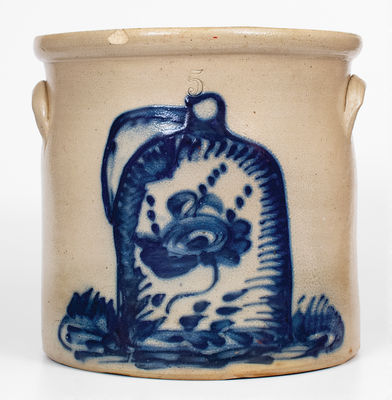Exceedingly Rare and Important Two-Gallon Stoneware Jug with Cobalt Indian Chief and Woman Decoration, attributed to the Thompson Pottery, Morgantown, WV, circa 1860, ovoid form with wide-mouthed spout and broad, heavily-ribbed handle, the side brush-decorated with a scene depicting an elderly Indian chief or medicine man with headdress and staff, facing a woman in dress with raised arm. Dotted flourish with tassels above. Shoulder decorated with a brushed floral motif with blossom petals flanking the capacity mark. Cobalt highlight to upper handle terminal. Among the most culturally significant examples of West Virginia stoneware that we have offered, this work is the only Morgantown piece depicting a Native-American that we are aware of. As much of the imagery of regional "people crocks" seems to draw from America's earliest beginnings as opposed to contemporary times, the design may reference William Penn's Treaty with the Indians or related events in colonial America. Provenance: Parke-Bernet Galleries, Inc., New York, NY, March 23-25, 1939, lot 238, sold as part of the collection of New York financier, Alfred Barmore Maclay (1871-1944). A notation on a piece of tape on the underside reads, "From McClay Collection / 1939- Very Rare! / CI.MP." Two other museum or collection codes on underside. This jug was the subject of a circa 1939 painting by artist, Giacinto Capelli, executed in watercolor, graphite, and colored pencil on paperboard, for the Index of American Design, now in the collection of the National Gallery of Art in Washington, D.C. (Accession number 1943.8.7065.) Some tight meandering lines to body of jug, not affecting decorated side. A small chip to top of handle. H 12 1/2".



















